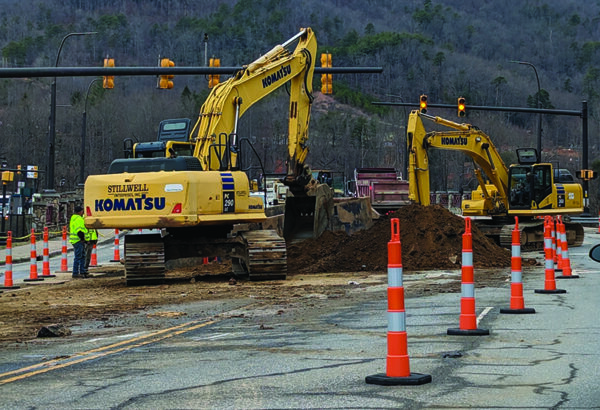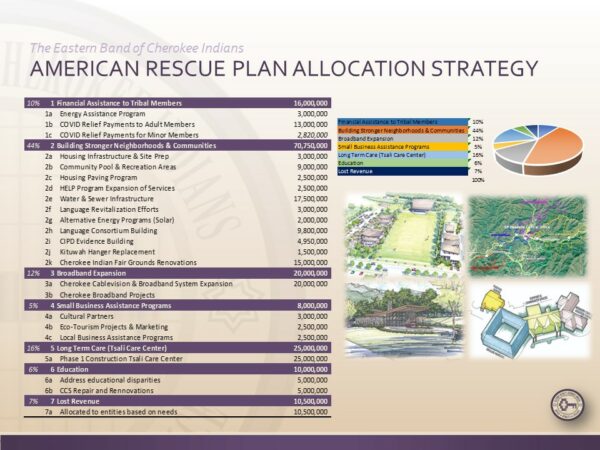By JONAH LOSSIAH
One Feather Reporter
CHEROKEE, N.C. The Eastern Band of Cherokee Indians (EBCI) was provided $160 million in federal funding in 2021 as part of the American Rescue Plan (ARP). Where does that money go?
EBCI Secretary of Treasury Cory Blankenship broke down that question and offered the allocation plan that has been crafted for the award. The simplified breakdown offers seven categories for dividing the pie, with each of those having specific projects and programs:
- Financial Assistance to Tribal Members – $16,000,000
- Building Stronger Neighborhoods and Communities – $70,750,000
- Broadband Expansion – $20,000,000
- Small Business Assistance Programs – $8,000,000
- Long Term Care (Tsali Care Center) – $25,000,000
- Education – $10,000,000
- Lost Revenue – $10,500,000

A total of $17.5 million of the ARP funding for the Eastern Band of Cherokee Indians has been designated for water and sewer infrastructure such as the sewer and water pipeline that is being implemented along Acquoni Rd. (ROBERT JUMPER/One Feather photo)
Secretary Blankenship said that the goal of ARP funding was to limit the sting from revenue loss during the COVID-19 pandemic, as well to establish long-term projects to lessen disparities among tribal communities. He said that it was an important boost to Cherokee at a time that the Tribe needed to supplement it loses.
“The ARP funding is the equivalent of all of the Federal awards that the Tribe would receive in a single fiscal year. So, our grant budget is just over $100 million a year from all sources. Whether those are Federal agencies, Indian Health Service, BIE, Department of Justice, Bureau of Indian Affairs, Department of Health and Human Services. If you think about all our programs that are grant funded, all the things that we have…you got in a single shot in the arm, a full year of grant funding to the Tribe. It is a significant portion of our budget.”
He said that it is important to understand that this money is heavily regulated. There needs to be reports on every federal dollar spent, and that’s why it’s so crucial to have a plan for spending it.
“Just like all other federal awards, there are requirements for how ARP can be spent,” said Secretary Blankenship. “There are requirements for how we report the expenditure of our dollars, and there are limitations on how long we have to spend. So, we have a pretty liberal timeline with the ARP funding. We have to be fully committed by 2024, then we have until 2026 to fully expend the funds. It’s possible that we get some extension of that.”
Large portions of this funding have already been spent, like the amount allotted to financial assistance to tribal members. This came in the form of the COVID relief payments that were distributed to adults and minors, as well as the energy assistance program that helped with household bills during the pandemic.
Some projects are ongoing, such as the sewer and water pipeline that is being implemented along Acquoni Rd. $17.5 million of the ARP funding has been designated for water and sewer infrastructure, and that includes this project.
$20 million is set to revamp and develop the tribal-wide broadband network. Secretary Blankenship said that this half of the estimated amount is going to take to establish this entire network, with the other half planning to be funded with tribal dollars.
He said that the EBCI has had to think on its feet throughout this process due to the amount of moving pieces involved with the ARP funding.
“We knew that ARP funding was coming in two payments. The first was everybody gets ‘x amount’ based on your enrollment. With 16,000 tribal members, we’re in the upper quartile of tribes in terms of population. We have a pretty significant population in terms of size…What we didn’t have an idea of is how much is that second payment going to be. When we estimated that second payment, it was just based on some variables … we estimated at the very beginning that we would receive about $117 million under ARP,” said Secretary Blankenship
The difference in this case is that the amount being worked with were truly estimates. Secretary Blankenship said that they didn’t know how much money they would be receiving until it was in the Tribe’s account. Not only that, but the Federal Treasury also didn’t release the full methodology regarding ARP funding until later.

(Graphic courtesy of EBCI Treasury Dept.)
“Typically, an agency will send you a notice of award and they’ll say how much you’ll be receiving. Treasury didn’t do that. It’s just, ‘we’re sending the first round of wires today, everyone check your accounts’. Then, $70 million in your account. And you have no idea what it’s going to be until it’s in the account.”
In total, the EBCI was allotted $160,302,523 in ARP funding through the two distributions. That does not include the $62.9 million that came from the CARES Act as well, bringing total Federal aid to the Tribe to $223.2 million.
The plan for how to allocate these funds was drawn up with Tribal leadership.
“There first thing that we did was sit down to have an off-site working session with Council. To review with them. Here’s the program, here’s the program parameters, here’s how much we’re expecting to receive, here are all the things that are allowed,” said Secretary Blankenship.
He also said that Executive and the secretaries were also involved in these meetings. The parameters he is referencing are outlined by several regulators.
“To support public health initiatives and expenditures related to public health, to address the negative economic impacts caused by public health emergency, replace lost public sector revenue, and to invest in water, sewer, and broadband infrastructure. In the actual act of Congress itself, those are the high-level of criteria for how you expend these funds. Then it flows over to the United States Department of Treasury, who release a few hundred pages of guidance on how funds can be expended. So, it’s not a scenario where we can say, ‘Tribes can do whatever they want with the money.’”
He said that they have had to consider where to use these federal dollars to be most efficient. Given that tribal dollars are significantly more flexible, the Tribe must be strategic when it comes to which pools of cash they pull from.
“I also think that it’s important when we’re considering projects that we’re very careful not to create facilities that would be a burden in the future in terms of maintenance. Also, being careful not to add things that have a significant amount of recurring operational costs. Could we have taken 50 million dollars and built a Tribal administration building? Probably. How much ongoing burden does that add to the Tribal budget? Some ways it may create efficiency and it could be a net-net. But how many of these smaller projects that we can do so we can see a tremendous amount of impact in our community. Over the long term, it’s a long-term investment.”
While there is a plan set forth for how to spend nearly all the federal award, the EBCI still has the ability to adjust as more projects come online.
“There is flexibility. One of the things we stressed to Tribal leadership and that we will stress to the public is that this is our plan as of today. A lot of these projects are started and they are underway. There are still some of these projects that are in planning phases. We have the flexibility as we get into them to say maybe this isn’t the best fit for ARP funding, let’s use Tribal funding. Let’s free up this ARP funding, let’s go back to Council.”
Secretary Blankenship said that the EBCI could’ve survived without the aid, but it would’ve been difficult. He said that the funding allowed the Tribe to stay operational when everything was in question, and that it is helping the EBCI transition to the post-pandemic economic landscape.
“I think the most critical thing about the ARP funding was that it provided a safety net during a time when we had full closure of our casino gaming operation…we were able to utilize that funding so that the pain of that lost revenue both on the Tribe and on the individual Tribal member was significantly less than it could’ve been.”





